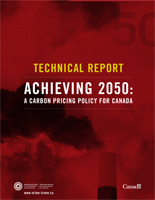Achieving 2050: A Carbon Pricing Policy for Canada – Technical Report
 Establishing a price on carbon is one of the most powerful mechanisms available to reduce greenhouse gas emissions that cause climate change. Carbon pricing motivates businesses and individuals to reduce carbon emissions by providing incentives to invest in renewable energy and low-emission technologies and by making it more expensive to use damaging alternatives.
Establishing a price on carbon is one of the most powerful mechanisms available to reduce greenhouse gas emissions that cause climate change. Carbon pricing motivates businesses and individuals to reduce carbon emissions by providing incentives to invest in renewable energy and low-emission technologies and by making it more expensive to use damaging alternatives.
This Report provides technical background information and analysis in support of the NRTEE Advisory Note, Achieving 2050: A Carbon Pricing Policy for Canada. The Technical Report has two main purposes:
(1) The report complements the Achieving 2050: A Carbon Pricing Policy for Canada, providing additional details on the analysis underpinning the conclusions in the Advisory Note. By integrating the research commissioned or developed by the NRTEE, including economic modelling, it illustrates the main Advisory Note’s grounding in credible and original analysis; and,
(2) The report provides a useful policy design framework and reference tool for policy makers. Designing carbon pricing policy to achieve deep and long-term carbon reduction targets is multifaceted and complex. This report both identifies important design and implementation issues but also evaluates trade-offs between the main design options for addressing these issues.
























